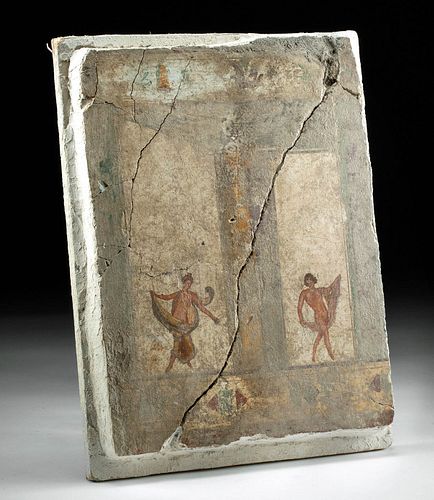Rare Roman Fresco, Fourth Style Painting
Lot 57a
About Seller
Artemis Fine Arts
686 S Taylor Ave, Ste 106
Louisville, CO 80027
United States
Selling antiquities, ancient and ethnographic art online since 1993, Artemis Gallery specializes in Classical Antiquities (Egyptian, Greek, Roman, Near Eastern), Asian, Pre-Columbian, African / Tribal / Oceanographic art. Our extensive inventory includes pottery, stone, metal, wood, glass and textil...Read more
Categories
Estimate:
$15,000 - $30,000
Absentee vs Live bid
Two ways to bid:
- Leave a max absentee bid and the platform will bid on your behalf up to your maximum bid during the live auction.
- Bid live during the auction and your bids will be submitted real-time to the auctioneer.
Bid Increments
| Price | Bid Increment |
|---|---|
| $0 | $25 |
| $300 | $50 |
| $1,000 | $100 |
| $2,000 | $250 |
| $5,000 | $500 |
| $10,000 | $1,000 |
| $20,000 | $2,500 |
| $50,000 | $5,000 |
| $100,000 | $10,000 |
| $200,000 | $20,000 |
About Auction
By Artemis Fine Arts
Oct 7, 2021
Set Reminder
2021-10-07 10:00:00
2021-10-07 10:00:00
America/New_York
Bidsquare
Bidsquare : Exceptional Antiquities Ethnographic Fine Art
https://www.bidsquare.com/auctions/artemis-gallery/exceptional-antiquities-ethnographic-fine-art-7537
Museum-worthy examples of Egyptian, Greek, Roman, Etruscan, Near Eastern, Far East / Asian, Pre-Columbian, African / Tribal, Oceanic, Native American, Spanish Colonial, Fossils, Ancient Jewelry, Fine / Visual Arts, so much more! Artemis Fine Arts info@artemisgallery.com
Museum-worthy examples of Egyptian, Greek, Roman, Etruscan, Near Eastern, Far East / Asian, Pre-Columbian, African / Tribal, Oceanic, Native American, Spanish Colonial, Fossils, Ancient Jewelry, Fine / Visual Arts, so much more! Artemis Fine Arts info@artemisgallery.com
- Lot Description
Roman, Imperial Period, ca. 1st century CE. An incredibly rare fresco painting depicting a pair of nude or partially nude women in dancelike poses within a colonnade, the petite women and their flowing scarves are delineated with fine lines and three-dimensional modeling, and the architecture is decorated with what appear to be phytomorphic and geometric motifs of sky blue, teal, golden yellow, red, and cream hues. In addition to the artist's ability to delineate depth of field and capture the movement of the lovely ladies below - clearly indicating the advances of Classical Art - the rarity of this piece is undeniable. Aside from vase painting, paintings from the Classical World are quite unusual, and this wall painting, possibly from Herculaneum or Pompeii, is extremely rare. Size: 16.5" L x 12.75" W (41.9 cm x 32.4 cm)
This is an example of a Roman Fourth Style wall painting. Fourth Style paintings reflect a taste for illusionism and rose to popularity during the mid-1st century CE. According to art historian Fred Kleiner, "it was the preferred manner of mural decoration at Pompeii when the eruption of Vesuvius buried the town in volcanic ash in 79." In Fourth Style wall paintings, the walls were usually painted a creamy white, and the illusionistic compositions resulted in views beyond the wall that also presented irrational architectural vistas with figures that were oftentimes out of scale as displayed in this example. Interestingly, scholar Paul Zanker has stated that Fourth Style wall painting were designed to turn the rooms into picture galleries called pinacothecae. (See Zanker, P. 1998. Pompeii: Public and Private Life. Trans. D. L. Schneider. Cambridge, Massachusetts: Harvard University Press.)
Pompeii was destroyed by and buried under the ash of a volcanic eruption in the year 79 CE. This natural catastrophe resulted in the preservation of extraordinary archaeological remains of the Roman town. The remains of Pompeii have been an invaluable resource for studying the Roman world.
For a similar example, see panels of the upper border of the Fourth Style paintings in the Ixion Room (triclinium P) of the House of the Vetti (Casa dei Vettii), Pompeii, Italy, ca. 70-79 CE or room 78 of the Domus Aurea (Golden House) of Nero, Rome, Italy, 64-68 CE. (Fred Kleiner, Gardner's Art through the Ages, Volume 1, Figures 7-22 and 7-23, p. 195).
This piece has been searched against the Art Loss Register database and has been cleared. The Art Loss Register maintains the world's largest database of stolen art, collectibles, and antiques.
Provenance: East Coast collection, New York Gallery, New York City, New York, USA, acquired before 2010
All items legal to buy/sell under U.S. Statute covering cultural patrimony Code 2600, CHAPTER 14, and are guaranteed to be as described or your money back.
A Certificate of Authenticity will accompany all winning bids.
PLEASE NOTE: Due to recent increases of shipments being seized by Australian & German customs (even for items with pre-UNESCO provenance), we will no longer ship most antiquities and ancient Chinese art to Australia & Germany. For categories of items that are acceptable to ship to Australia or Germany, please contact us directly or work with your local customs brokerage firm.
Display stands not described as included/custom in the item description are for photography purposes only and will not be included with the item upon shipping.
#136222Repaired and restored from multiple pieces with some visible fissures. Cleaned by Joseph Ternbach in Forest Hills, New York in the mid to late 1950's. Relatively little touch up consolidation. Surface wear with some pitting, abrasions, and pigment loss commensurate with age. Set in a plaster matrix, with a wooden backing for added support.Condition
- Shipping Info
-
All shipping is handled in-house for your convenience. Your invoice from Artemis Gallery will include shipping calculation instructions. If in doubt, please inquire BEFORE bidding for estimated shipping costs for individual items.
-
- Buyer's Premium



 EUR
EUR CAD
CAD AUD
AUD GBP
GBP MXN
MXN HKD
HKD CNY
CNY MYR
MYR SEK
SEK SGD
SGD CHF
CHF THB
THB















